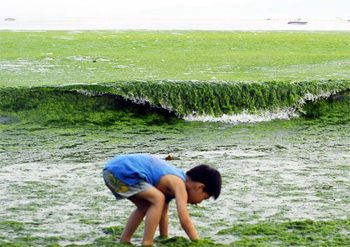 FreshProduceJournal.com | by: D. Lee
FreshProduceJournal.com | by: D. Lee
August 01, 2011
The green algae bloom returns to China this summer and Chinese vacationers have learned to take it in stride.
In 2008, China hosted the 29th Summer Olympic Games. In addition to the usual preparations that are required of the host nation, China faced an unexpected green challenge. Local and regional governmental agencies had the burden of removing a massive green algae bloom that threatened the games venue for the sailing competition.
The Enteromorpha prolifera bloom overwhelmed the coastal region of Qindao, China and covered an area of over 15,000 square miles. According to a report published by Nature Precedings, approximately 1 million tons of algae were removed from the beaches and coastal waters by more than 16,000 people. The green was gone, the sailing competitions were a success, but the cost of cleanup reached into the billions of Chinese Yuans.
The Olympic Games algae bloom was not the first, nor would it be the last to threaten the coastal regions of the Yellow Sea. In July-August 2007 a green algae bloom occurred on a much smaller scale. And now this summer, the Daily Mail reports that China’s holiday resort in Qindao is once again suffering from a 4,500 square mile bright green algae bloom. Seemingly undeterred, Chinese vacationers take to the surf and frolic in the waves of green.
Most reports which describe these events as harmless to humans and of unknown origin miss a larger point and ignore important research. These algae blooms are occurring with greater frequency around the globe and threaten marine life and fragile eco-systems.
The World Wildlife Fund published a 2009 report describing the problem of eutrophication, or nutrient pollution. In the report, The Invisible Threat to the Baltic Sea: Spring Algae Blooms, eutrophication has been identified as the “single biggest threat to the health of the Baltic Sea.” The report explains that nitrogen load is the single largest contributor to the powerful spring blooms and reaches the sea via rivers. It describes how large amounts of nutrients, mainly nitrogen and phosphorus, are released into the sea from three main sources: agriculture, waste water and the combustion of fossil fuels. The report says that agricultural practices are responsible for 40% of the phosphorus and 60% of the nitrogen emissions in the Baltic Sea.
These practices are now known to be responsible for algae blooms that create dead zones where hypoxic (low-oxygen) areas are formed by dead and decomposing algae which consumes oxygen as it sinks to the bottom of the sea. A 2003 report published by the United Nations Environment Programme reported 146 dead zones where marine life could not be supported due to insufficient oxygen. A later study by Diaz and Rosenberg titled, Spreading Dead Zones and Consequences for Marine Ecosystems, reported that by 2008 there were over 400 dead zones worldwide.
Like the algae blooms elsewhere in the world, the Yellow Sea blooms are caused by an interaction of the people and the land; the land and the oceans; and the oceans and the life they support. These interactions are interwoven with the cycles of the seasons and the complexity of a changing climate. China’s explosive development has been a 21st century marvel, but often with some undesired and unintended consequences. As China’s population and economy continue to grow, they must identify and meet the challenges that accompany the rapid expansions of agriculture and urbanization; and they must do so in a way that promises a sustainable way forward.
email the author: d.lee@freshproducejournal.com
image: By Ker Than, National Geographic as displayed on coastalcare.org